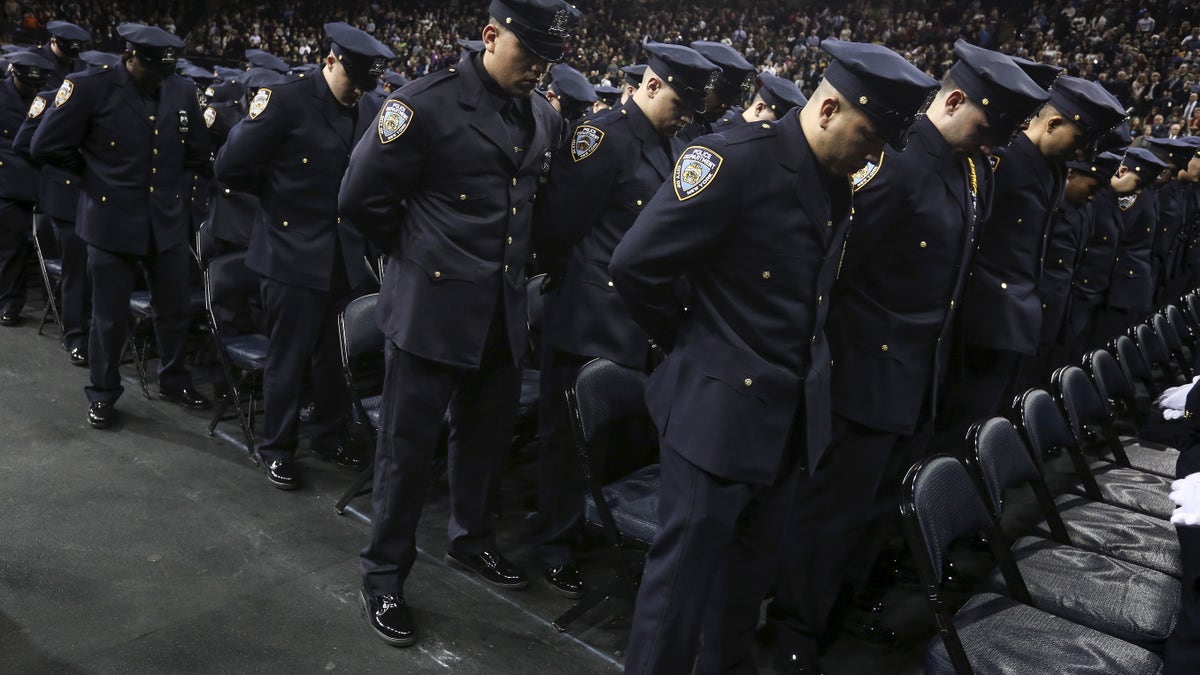
Dec. 29, 2015- Newly inducted New York Police officers observe a solemn moment at a graduation ceremony at Madison Square Garden. (REUTERS)
Saturday, January 9 is Law Enforcement Appreciation Day.
It could not come soon enough after a tumultuous 2015 that saw law enforcement in America under extraordinary pressure -- assailed in the national media and facing criticism from many quarters. Police across America are on their heels, fearful of becoming the target of the next viral video and having their actions judged by armchair quarterbacks.
That’s why we should thank the Washington Post for an unexpected holiday gift as the year came to an end. The paper published a recent summary of fatal 2015 police shootings which reveals some realities about police use of deadly force.
Over the past year, few national news outlets could lay claim to as many anti-police articles, commentaries, cartoons, and sentiments as the Washington Post. With consistent reliability, the Post publishes blaring headlines and articles centered on raising doubt, fanning racial flames, and sowing discontent between the public and law enforcement. Whether the topic is encryption, surveillance, data collection, chases, or the use of force, the Post’s theme is consistent – “Law enforcement got it wrong. Again.”
So, what a wonderful gift when the Post showed uncharacteristic fortitude and featured a researched article, contrary to all it suggests, on the subject of police use of fatal force. What’s more, the details of the Post’s research support what many law enforcement experts have been saying for some time.
According to the Post and government data, in a typical year there will be some 40 million encounters between law enforcement officers and the populace. Against that, there will be some 50,000 assaults on police and, according to the Post, in 2015 approximately 1000 lives taken by police deadly force.
One must wonder why the Washington Post dedicates so much of its publication to the minuscule likelihood that your life or mine might be ended by police force rather than our struggling economy, terrorism, the threatening international environment, or any number of other topics having far greater impact on the public.
The Post revealed the vast majority of police encounters ending in a citizen fatality involved an armed or attacking subject - 28 percent of those who died were shooting at officers or someone else, 16 percent were attacking with other weapons or physical force, and 31 percent were pointing a gun.
Out of these millions of police encounters during the past year, just 90 people (9%) killed by police in 2015 were unarmed. And those 90 were disproportionately minorities.
Evidently it was at this point that the Post’s research concluded. Without questioning the misguided and criminal actions of those, like Michael Brown, who undertook unarmed attacks on police, and without examining or discussing the realities of crime in America which demonstrates that blacks are disproportionately victims as well as perpetrators, the Post offers its expected refrain - racism is at work.
The truth is that violent encounters between citizens and police are complex and can hardly explained monolithically or with the Post's default viewpoint. In fact, criminality and crime fighting is far more complex; our criminal justice system and its many failings is a reflection of that reality.
Americans need to know that good police leaders are working overtime to change cultures, learn from the mistakes of others, and inspire the troops to greater community engagement.
They are keenly aware of the dangerous intersection of mental illness and use of force episodes, welcoming body cameras that might mitigate risks both toward and by citizens. But too many of them are underfunded, under trained, under equipped, and under led. For too many law officers, the injection of resources and training will come only after a crisis as local governments tasked with funding issues play “chicken” with the possibility of becoming the next Ferguson or the next Baltimore.
Let’s hope the Washington Post and other news outlets across the country report more of the truth regarding the challenges of law enforcement, especially in places where the benefits of government, society and family have failed.
And if you see a law enforcement officer Saturday, take a moment to express thanks or appreciation for the work they do to keep our communities safe.
